Calderdale history timeline 1850 - 1900AD
Reform and Development
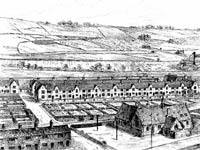 The traumatic urban-industrial experience eventually set in motion a movement
of social reform. In which, Luddites and Chartists, friendly
societies and co-operative groups, trade unions and reformers, industrial
paternalism and the new municipal authorities helped remove
the worst excesses of unfettered industrialism. Model villages and
co-operative 'club' houses emerged alongside some of the more squalid
mill terraces and overcrowded cellar dwellings. The emerging
civic pride came to be expressed in an increasing range of public
buildings and amenities.
The traumatic urban-industrial experience eventually set in motion a movement
of social reform. In which, Luddites and Chartists, friendly
societies and co-operative groups, trade unions and reformers, industrial
paternalism and the new municipal authorities helped remove
the worst excesses of unfettered industrialism. Model villages and
co-operative 'club' houses emerged alongside some of the more squalid
mill terraces and overcrowded cellar dwellings. The emerging
civic pride came to be expressed in an increasing range of public
buildings and amenities.
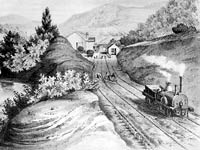 Parliamentary
enclosure represented a final phase of moorland reclamation for food
production for the expanding population. Leaving its mark in the high-lying
laithe-house hill farms, which usually combined under one roof a house,
barn and mistal. While huge reservoirs were constructed to quench
the thirst and improve the sanitation of the new industrial communities.
The transport revolution that had been initiated by canal and turnpike
was completed during the 1840s. This was along with the opening of the first railway
line through Calderdale.
Parliamentary
enclosure represented a final phase of moorland reclamation for food
production for the expanding population. Leaving its mark in the high-lying
laithe-house hill farms, which usually combined under one roof a house,
barn and mistal. While huge reservoirs were constructed to quench
the thirst and improve the sanitation of the new industrial communities.
The transport revolution that had been initiated by canal and turnpike
was completed during the 1840s. This was along with the opening of the first railway
line through Calderdale.
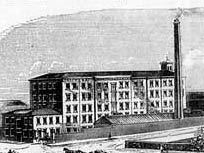 In
Halifax, the second half on the 19th century was marked by exceptional
growth. Urban development taking the form of continuous westward
and northward expansion. This eventually engulfed the nearby settlements
of King Cross, Mount Pellon and Haley Hill. Much of this later development
was due to textile mills being built over the higher ground to
the west. This was rather than their continued concentration in the Hebble
Valley, following the provision of mains water and drainage.
In
Halifax, the second half on the 19th century was marked by exceptional
growth. Urban development taking the form of continuous westward
and northward expansion. This eventually engulfed the nearby settlements
of King Cross, Mount Pellon and Haley Hill. Much of this later development
was due to textile mills being built over the higher ground to
the west. This was rather than their continued concentration in the Hebble
Valley, following the provision of mains water and drainage.
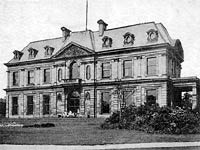 Alongside
this industrial development, there was a great deal of other building development. This included: schools and mechanics institutes, hospitals,
almshouses and a union workhouse, parks, public baths, cemeteries and
gas works. There was also the public library (see opposite) and museum. This gradually
took shape in the town and in the satellite communities to which it
was increasingly linked. Transport communications were improved by rail (from 1844), horse omnibus (from the
1850s) and tram (from 1898). All this served as agencies of both social control
and social construction. This reflected the dynamic interplay of forces
that ensured a healthier, more hierarchically regulated environment. This was needed
for the expanding urban workforce.
Alongside
this industrial development, there was a great deal of other building development. This included: schools and mechanics institutes, hospitals,
almshouses and a union workhouse, parks, public baths, cemeteries and
gas works. There was also the public library (see opposite) and museum. This gradually
took shape in the town and in the satellite communities to which it
was increasingly linked. Transport communications were improved by rail (from 1844), horse omnibus (from the
1850s) and tram (from 1898). All this served as agencies of both social control
and social construction. This reflected the dynamic interplay of forces
that ensured a healthier, more hierarchically regulated environment. This was needed
for the expanding urban workforce.
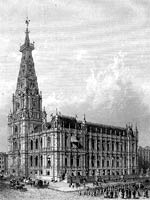 The
Town Hall (1863) and Borough market (1896), formed a radical
two-phase redevelopment of Halifax. This provided a vivid expression of
the corporate identity of the municipal authority. At the same time, new industrial entrepreneurs boldly
proclaimed their wealth and status. They built large Victorian
'country' mansions (Belle Vue, 1857 and Bankfield, 1867) and ornate
gothic churches (Square Church, 1857, and All Souls', 1859). Those who helped to shape the cultural and spiritual values of Victorian
society.
The
Town Hall (1863) and Borough market (1896), formed a radical
two-phase redevelopment of Halifax. This provided a vivid expression of
the corporate identity of the municipal authority. At the same time, new industrial entrepreneurs boldly
proclaimed their wealth and status. They built large Victorian
'country' mansions (Belle Vue, 1857 and Bankfield, 1867) and ornate
gothic churches (Square Church, 1857, and All Souls', 1859). Those who helped to shape the cultural and spiritual values of Victorian
society.


